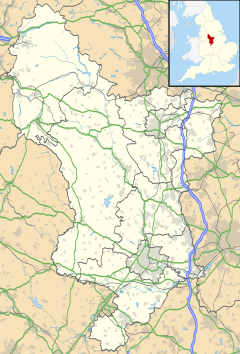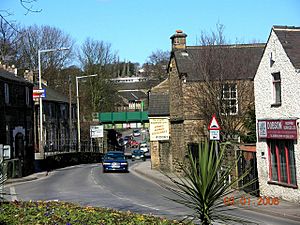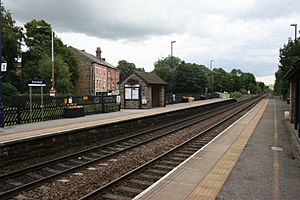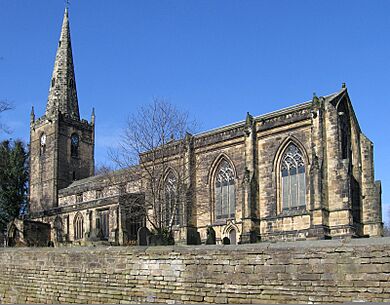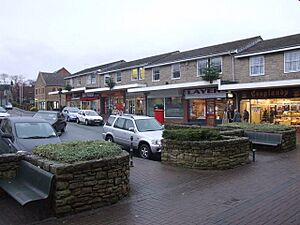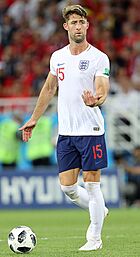Dronfield facts for kids
Quick facts for kids Dronfield |
|
|---|---|
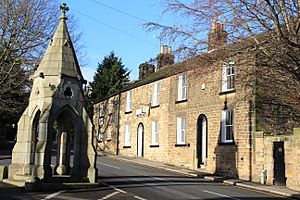 Peel Monument and High Street |
|
| Population | 21,261 (2011 census) |
| OS grid reference | SK355785 |
| District |
|
| Shire county | |
| Region | |
| Country | England |
| Sovereign state | United Kingdom |
| Post town | DRONFIELD |
| Postcode district | S18 |
| Dialling code | 01246 |
| Police | Derbyshire |
| Fire | Derbyshire |
| Ambulance | East Midlands |
| EU Parliament | East Midlands |
| UK Parliament |
|
Dronfield is a town in North East Derbyshire, England. It includes the areas of Dronfield Woodhouse and Coal Aston. The town sits in the valley of the River Drone, between the larger towns of Chesterfield and Sheffield. The beautiful Peak District National Park is only about 3 miles (5 km) to the west. The name Dronfield comes from an old English word, Dranfleld. It probably means "open land where many drone bees live."
Dronfield was already a town before the famous 1086 Domesday Book was written. It has a church that is over 700 years old! In 1662, King Charles II allowed the town to have its own market. This market later stopped, but a new one is held every Thursday. For many years, Dronfield was known for coal mining, making wool, soap, and steel, and for engineering. Today, many different types of factories and businesses still work in the town. The football stadium north of Dronfield is called "The Home of Football." It is where Sheffield F.C., the world's oldest football club, plays its games.
Dronfield's population has grown a lot. In 1945, about 6,500 people lived there. By 2011, this number had grown to 21,261.
Contents
History of Dronfield
Dronfield was a settlement even before the Domesday Book was created in 1086. Not much is known about its very early days. After the Norman conquest of England, King William the Conqueror wanted to control the north. This caused some difficulties for Dronfield. The town's name comes from old English words meaning "open land with many male bees."
The Church of St John the Baptist was built by 1135. At that time, the Dronfield church area covered many nearby villages. A special religious group called the Guild of the Blessed Virgin Mary started in 1349. However, in 1547, many religious groups were stopped. This guild's hall became a local inn, which is still known as the Green Dragon Inn today.
In the 1500s, Dronfield had many sheep farmers. A lot of families worked with wool, spinning thread, weaving cloth, and selling it. Soaper Lane, near the river, was where soap making and leather tanning happened. There was also a dye works there. In 1662, King Charles II gave Dronfield the right to hold a market. But in the 1700s, because Sheffield and Chesterfield were so close, the market became less popular. However, a market is still held every Thursday in the civic centre car park.
Between the 1500s and 1800s, Dronfield grew because of different industries. The most common was coal mining. Coal pits were mentioned in the 1500s. More mines opened in Coal Aston in 1785 and Dronfield Woodhouse in 1795. The town also traded with lead miners and grindstone makers from the Peak District. The rich Rotheram family, who owned much of Dronfield, made their money from the lead trade.
A large steelworks, Wilson-Cammell, was built in Dronfield in 1872–73. This happened after the Midland Main Line railway came through the town in 1869. The steelworks started making Bessemer steel in 1873. It could soon make 700 tons of steel, mostly for railway tracks, each week. Dronfield quickly became a very busy and wealthy town. But this success did not last long. Even though the Dronfield steelworks was good, it could not compete with factories built closer to the coast. In 1883, the steel production moved to Workington. Many steelworkers and their families moved too. About 1,500 people from Dronfield moved to Workington. The people of Workington called the newcomers 'Dronnies'. These 'Dronnies' even started their own football team, Workington AFC, in 1888.
In 1993, Dronfield Henry Fanshawe School had a big fire. The newer buildings from the 1960s were completely destroyed. Firefighters from all nearby towns and Sheffield came to help. The older Victorian part of the school and the library were saved. The damaged parts were pulled down, and temporary classrooms were used. The school was rebuilt by 1996.
The Dronfield Civic Hall was completely rebuilt in 1999.
Where is Dronfield?
Dronfield is located in the valley of the River Drone in North East Derbyshire, England. The Drone is a small river. After flowing through Dronfield, it joins another stream and then flows into the River Rother near Chesterfield.
Dronfield is about halfway between Chesterfield to the south and Sheffield to the north. Many people who live in Dronfield travel to work in these bigger cities. A main road, the A61 Dronfield–Unstone Bypass, goes around the town. You cannot get to the town centre directly from this bypass. Instead, smaller local roads serve the town. Dronfield also has its own train station, Dronfield railway station.
Dronfield covers an area of about 3,457 acres (14 square kilometres). Its neighbours are the villages of Unstone, Holmesfield, Barlow, Apperknowle, Hundall, Marsh Lane, and Eckington.
The town is close to the Pennines hills and many beautiful places in Derbyshire. It is also very close to the Peak District National Park, which is only about 3 miles (5 km) away. Dronfield has four special conservation areas. These are places protected for their natural beauty or history. They include the old village centres of Dronfield, Coal Aston, and Dronfield Woodhouse.
What Dronfield Makes and Does
Dronfield has many different businesses. Most of them are on the Callywhite Lane Industrial Estate, in the eastern part of town. Other businesses are along Wreakes Lane and Stubley Lane. In the past, the main businesses were related to engineering. But now, they do many different things. William Lees Iron Foundry, which makes machine parts, moved to Dronfield in 1870. This helped the town grow a lot. They used to make special iron castings, and now they make other types of iron.
Some big companies with offices or factories in Dronfield include:
- Henry Boot PLC: This company builds things and develops properties.
- Padley & Venables Ltd: They make tools for drilling, mining, and building.
- Land Instruments International: They design and make tools to check industrial and environmental conditions.
- Gunstones Bakery: This bakery started in Sheffield in 1862 and moved to Dronfield in 1950. It is now owned by 2 Sisters and employs over 1,400 people.
People of Dronfield
In the 2011 census, Dronfield's area (including Coal Aston and Dronfield Woodhouse) had 21,261 people. There were slightly more females (10,928) than males (10,333). About 25% of the people were aged 65 or older. About 16% were under 16 years old. Most of Dronfield's population (98.3%) were of white ethnicity.
On October 16, 1975, a new bypass road, the A61 Dronfield–Unstone Bypass, opened. It cost £6.5 million and is about 5 miles (8 km) long. This road helps people travel more easily between Sheffield and Chesterfield. Because of this, Dronfield is often called a "dormitory community." This means many people live in Dronfield but travel to work in the bigger nearby cities.
Important Buildings
In Dronfield, there are 42 buildings that are officially "listed" by Historic England. This means they are important because of their history or special design.
- One building, the parish church of St John the Baptist, is listed as Grade I, which is the highest level.
- Four buildings are Grade II*, which means they are very important. These include Aston End, Chiverton House, Dronfield Woodhouse Hall farmhouse, and a building near The Hall on High Street.
- All the other listed buildings, like Dronfield Manor and the Peel Monument, are Grade II.
The parish church of St. John the Baptist was built between the late 1200s and 1300s. It was changed a bit in the mid-1500s. The church has walls made of sandstone and roofs made of slate and lead. It has a tall, pointed spire. Repairs were made in 1819, 1855, and 1916. Inside, there are over 120 brass plaques and monuments on the floor.
Aston End is a very old house from the Middle Ages. It was changed and added to in the 1500s, 1600s, and 1800s. Chiverton House was built between 1692 and 1709. It has a flat, balanced front with special windows and towers at each end. It was changed a little in the 1700s and 1800s. Its walls, gateposts, and railings are also part of its listing. Dronfield Woodhouse Hall farmhouse was built in 1533. It has an unusual shape and is made of sandstone. It was changed a lot in the early 1700s and later. The building northeast of The Hall on High Street used to be a farm building from the late 1600s. It also has parts of an even older timber-framed building, possibly from the Middle Ages. In 2004, this building was in poor condition and was given to the community. In 2015, it was fixed up and made bigger for over £1.6 million. Most of the money came from the Heritage Lottery Fund. Now, it is a visitor centre where people can learn about history. It also has spaces for exhibitions and community events.
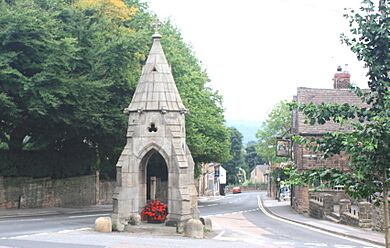
The Peel Monument is on the town's High Street. It was built in 1854 from gritstone. It honours Sir Robert Peel, who changed some important laws about food prices in 1846. The monument is very easy to recognise and is often seen in pictures of Dronfield.
Near the Peel Monument, there is a 1500s house called The Cottage. Some people believe that the famous poet Lord Byron (1788–1824) once owned it. However, there is no clear proof that he lived in Dronfield.
Fun and Community in Dronfield
Culture
Dronfield has some fun yearly events. These include the Dronfield Gala and the Dronfield Woodhouse and Coal Aston well dressings, which happen in July. Well dressing is a special tradition where pictures are made using flower petals and other natural materials. Dronfest, a music festival, also takes place in the town during the summer.
Since 1972, Dronfield has been twinned with Sindelfingen in Germany. To celebrate this friendship, a park in Dronfield Woodhouse was renamed Sindelfingen Park in the early 1990s. Dronfield Henry Fanshawe School has a student exchange program with a school in Sindelfingen each year. This helps young people from both towns get to know each other.
Community Facilities
Dronfield has a library, a sports centre, a health centre, and a community centre. There are three parks: Cliffe Park, Sindelfingen Park, and Jubilee Park. There are also several play areas for children. Cliffe Park has tennis courts, a basketball court, a children's play area, and a bowling green. Sindelfingen Park has play areas and basketball courts.
In January 2010, a new sports complex opened at Gosforth Fields. It cost £2.5 million. Three local sports teams, AFC Dronfield, Dronfield Town, and Dronfield RFU, run the complex. It has a modern 3G football pitch, 10 full-size pitches, changing rooms, and a social area. Sir Trevor Brooking and John Owen officially opened it. Gosforth Fields is the home of Dronfield Rugby Club.
Dronfield also has several social clubs, like The Contact Club and the Pioneer Club. The 1890 (Dronfield) ATC Squadron, a youth organisation, is also based in Dronfield.
Media
Local news and TV shows for Dronfield come from BBC Yorkshire and ITV Yorkshire. TV signals are received from transmitters in Emley Moor, Sheffield, or Chesterfield.
Local radio stations include BBC Radio Sheffield, Greatest Hits Radio North Derbyshire, and Chesterfield Radio.
The town has a local newspaper called the Derbyshire Times. There is also a monthly magazine called The Dronfield Eye. This magazine also publishes the yearly Dronfield Directory, which lists local groups and organisations.
Dronfield Digital is an online publication for young people. It started in late 2012 and shares opinions, fake news, and funny stories about life in Dronfield.
Schools in Dronfield
- Dronfield Henry Fanshawe School on Green Lane is a large secondary school. It takes students from all eight primary schools in Dronfield and nearby areas. Sometimes, students from Sheffield and Chesterfield also attend. In November 2015, it had 1,779 students.
- Dronfield Junior and Infants Schools are the biggest primary schools in Dronfield, with over 600 students.
- William Levick Primary School had 169 students in May 2016.
Sports and Fun
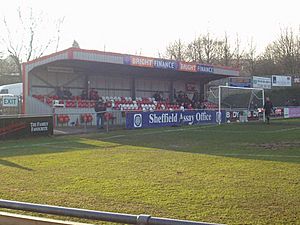
Two main football clubs play in Dronfield:
- Sheffield F.C., the world's oldest football club, plays at The Home of Football Stadium.
- Dronfield Town plays at the Stonelow Playing Fields.
Norton Woodseats F.C. used to be from Sheffield but played most of their games in Dronfield.
There is also a rugby league team called Dronfield Drifters RLFC.
The leisure centre is next to the civic centre, offering various sports activities.
The cricket ground on Stonelow Road is home to the Coal Aston Cricket Club. It has good facilities, including changing rooms, a tea room, and a practice net.
The Dronfield 2000 Rotary Walk is a 14.5-mile (23.3 km) circular path that goes all the way around the town.
Famous People from Dronfield
Many notable people were either born in Dronfield or have lived there:
- Rick Allen (born 1963), the drummer for the rock band Def Leppard, was born in Dronfield.
- Harry Barnes (born 1936), a local politician, has lived in Dronfield since 1969.
- Dave Berry (born 1941), a musician, lives in the town.
- Michael Caine (born 1933), the famous film actor, lived in Dronfield in the early 1960s.
- Gary Cahill (born 1985), a footballer who played for Crystal Palace and England, grew up in Dronfield and went to Dronfield Henry Fanshawe School.
- Bruce Chatwin (1940–1989), a novelist and travel writer, was christened in the local church and lived in Dronfield for a short time after he was born.
- Jessica Cunningham (born 1987), a contestant on the TV show The Apprentice in 2016.
- Roy Goodall (1902–1982), a footballer who played many games for Huddersfield Town and for England, was born here.
- John Hewitt (1880–1961), a zoologist and archaeologist who studied reptiles and amphibians in South Africa, was born here.
See also
In Spanish: Dronfield para niños


